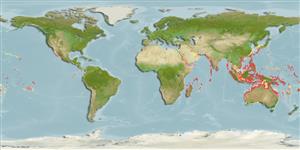>
Gobiiformes (Gobies) >
Gobiidae (Gobies) > Gobiinae
Etymology: Trimma: Greek, trimma, -atos = something crushed (Ref. 45335); macrophthalmus: Origin of name not given, but presumably from ‘macro’ for large and the Greek noun ‘opthalmos’, meaning eye; originally spelled as ‘macrophthalmus’, and the spelling is retained because the second half of the specific name is a noun; thus treated as noun in apposition..
Environment: milieu / climate zone / depth range / distribution range
Ecologia
marino associati a barriera corallina; distribuzione batimetrica 5 - 35 m (Ref. 90102). Tropical
Western Pacific: Cocos (Keeling) to Vietnam and Japan, south and east to the Great Barrier Reef, Fiji, and Samoa.
Size / Peso / Age
Maturity: Lm ? range ? - ? cm
Max length : 2.5 cm TL maschio/sesso non determinato; (Ref. 2798)
Spine dorsali (totale): 7; Raggi dorsali molli (totale): 9-10; Spine anali 1; Raggi anali molli: 8 - 9. Very similar to T. okinawae but lacks predorsal scales (Ref. 37816). Body with ctenoid scales except ventral midline and pectoral base with cycloid scales. Transverse scales 7-8. Mouth slightly oblique upwards. Second spine longest in 1st dorsal; rays of 2nd dorsal nearly equal; anal fin similar to 2nd dorsal; pectoral reaches to vertical of anus; pelvic fins without frenum but connected to basal membrane (Ref. 43541); characterized further by body with greyish matrix with dense red to orange spotting on head and body; median fins with faint yellow spotting; pair of large red spots on base of pectoral fin; longitudinal scale series 26-27; cheek and opercle without scales; depth of body 3.9-4.2 in TL (Ref. 90102).
Bottom-dweller of seaward reefs (Ref. 37816). Usually in small groups in caves and under ledges (Ref. 90102).
Life cycle and mating behavior
Maturità | Riproduzione | Deposizione | Uova | Fecundity | Larve
Winterbottom, R., 2019. An illustrated key to the described valid species of Trimma (Teleostei: Gobiidae). J. Ocean Sci. Found. 34:1-61. (Ref. 121207)
IUCN Red List Status (Ref. 130435)
Threat to humans
Harmless
Human uses
Informazioni ulteriori
Nomi ComuniSinonimiMetabolismoPredatoriEcotossicologiaRiproduzioneMaturitàDeposizioneSpawning aggregationFecundityUovaEgg development
BibliografiaAcquacolturaProfilo di acquacolturaVarietàGeneticaElectrophoresesEreditarietàMalattieElaborazioneNutrientsMass conversion
CollaboratoriImmaginiStamps, Coins Misc.SuoniCiguateraVelocitàModalità di nuotoArea branchialeOtolithsCervelliVista
Strumenti
Special reports
Download XML
Fonti Internet
Estimates based on models
Preferred temperature (Ref.
123201): 24.1 - 28.8, mean 27.5 °C (based on 420 cells).
Phylogenetic diversity index (Ref.
82804): PD
50 = 0.5000 [Uniqueness, from 0.5 = low to 2.0 = high].
Bayesian length-weight: a=0.01023 (0.00477 - 0.02194), b=3.02 (2.84 - 3.20), in cm total length, based on LWR estimates for this (Sub)family-body shape (Ref.
93245).
Resilienza (Ref.
120179): Alto, tempo minimo di raddoppiamento della popolazione meno di 15 mesi (Preliminary K or Fecundity.).
Fishing Vulnerability (Ref.
59153): Low vulnerability (10 of 100).
Nutrients (Ref.
124155): Calcium = 385 [169, 1,328] mg/100g; Iron = 1.91 [0.80, 4.23] mg/100g; Protein = 18.1 [15.9, 20.0] %; Omega3 = 0.169 [0.053, 0.527] g/100g; Selenium = 37.4 [11.0, 106.6] μg/100g; VitaminA = 93.3 [17.8, 476.1] μg/100g; Zinc = 4.67 [2.47, 7.84] mg/100g (wet weight);
